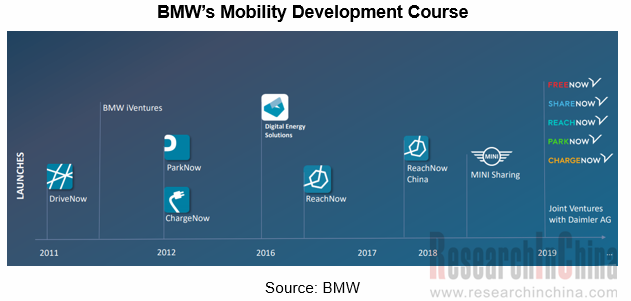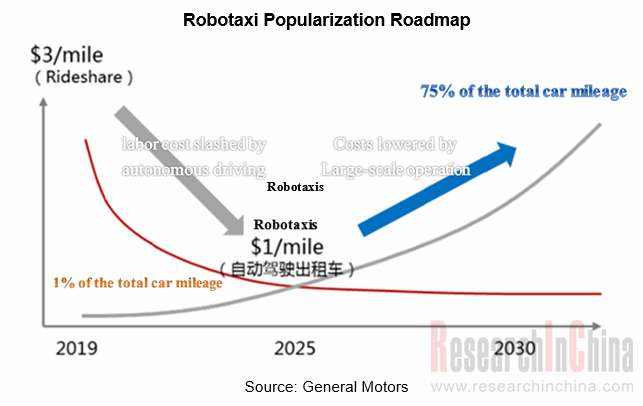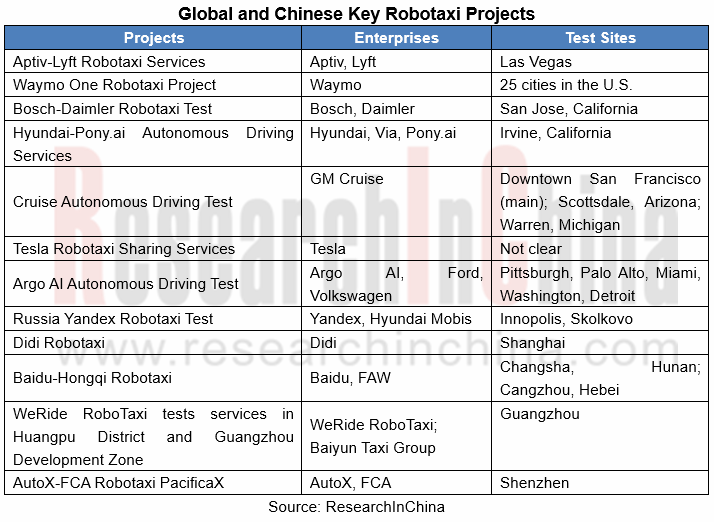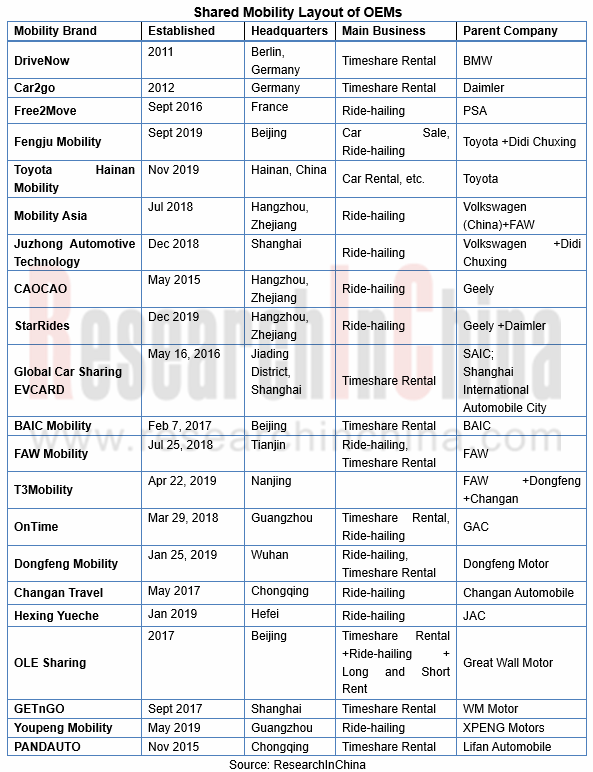Shared Mobility Industry Research--Autonomous Driving Leads Shared Mobility 3.0
The global shared mobility industry is experiencing a hard time. It is since 2019 that shared mobility enterprises have been exposed to financial fragility and have closed down one after another amid a nosedive in financing amount and rounds. The COVID-19 pandemic makes things worse. Shared mobility companies such as Uber and Lyft have cut jobs, while many automakers and Robotaxi companies have dabbled in the shared mobility market.
Tan Yi from GoFun believes that Shared Mobility 1.0 refers to the current public transit system, 2.0 means the new formats -- ride-hailing and timeshare rental occurring now, and 3.0 represents the application of autonomous driving in the future.
Shared mobility is closely related to autonomous driving. It is difficult for both of them to make money at this stage.
By 2030, the global Robotaxi fleet market will be worth at least US$2 trillion annually, 12% of new cars will be sold to Robotaxi fleets globally, and 26 million Robotaxis will be in operation, as estimated by UBS Evidence Lab.
To have a bite of the future shared mobility market, the giants have offered subsidies to squeeze small and medium-sized mobility firms. Only the full exertion of autonomous driving can make the shared mobility market scale up, but the current immature autonomous driving technology, regulations and business models makes the goal impossible.
The shared mobility market is the battlefield of vibrant players who still need fight in alliance. WAYMO has tested Robotaxi for ten years. BMW has been groping for shared mobility business for almost a decade, but it eventually allied with Daimler to push on deeper cooperation on autonomous driving and shared mobility.

A study by General Motors shows that the cost of shared mobility will be slashed from $ 3 / mile to $1 / mile through autonomous driving by 2025, thereby diluting the operation cost through a large scale. After 2030, the mobility mileage of Robotaxis will constitute 75% of the total.


That is to say, autonomous driving will not give much impetus to shared mobility until 2025. From now on, it is a challenge for ambitious companies to make a layout in just five years. Looking back at the players’ Robotaxi trials in 2019, we can see that fiercer rivalry is under way.
Trial Operation of Robotaxi
Three major forces are competing for the Robotaxi market, including:
(1) Didi, Uber, Lyft and other mobility platforms;
(2) Waymo, Aptiv, Baidu, Pony.ai and other Robotaxi solution providers;
(3) OEMs. Tesla plans to launch a Robotaxi network involving over a million Robotaxis on the road. Waymo has secured US$3 billion in financing for enlarging the Robotaxi test fleet. Baidu announced in April 2020 the availability of China's first Robotaxi services which are being offered on mobile apps to the public.

Although a few giants and top Robotaxi startups are making long-term plans, it is still too early for most automakers, most of which have launched their own mobility service brands successively and made attempts in the lucrative but fiercely contested mobility market.

Global and China Leading Tier1 Suppliers’ Intelligent Cockpit Business Research Report, 2022 (II)
Tier1 Intelligent Cockpit Research: The mass production of innovative cockpits gathers pace, and penetration of new technologies is on a rapid riseGlobal OEMs and Tier 1 suppliers are racing for the i...
Global and China Leading Tier1 Suppliers’ Intelligent Cockpit Business Research Report, 2022 (I)
Tier1 Intelligent Cockpit Research: The mass production of innovative cockpits gathers pace, and penetration of new technologies is on a rapid riseGlobal OEMs and Tier 1 suppliers are racing for the i...
China Commercial Vehicle Intelligent Cockpit Industry Report 2021
Research on Intelligent Cockpits of Commercial Vehicles: Heading for Large Screens, Voice Interaction, Entertainment and Life
Following AD/ADAS functions, the intelligent configuration of the cockpit...
Automotive Ultra Wide Band (UWB) Industry Report, 2022
UWB got initially utilized in the military field, and began to be commercially applied after the release of criteria for UWB commercialization in 2002. In 2019, Car Connectivity Consortium (CCC) liste...
China Automotive Distribution and Aftermarket Industry Report, 2022-2027
Since the introduction of 4S store model into China at the end of 20th century, China's authorized dealer system has gradually developed from a single-store-based mode to a group-based mode, and from ...
Global and China Skateboard Chassis Industry Report, 2021-2022
Research into skateboard chassis: where to sell, how to sell and to whom it is sold
Rivian, a new carmaker based on skateboard chassis, is quite popular in the market and becomes the focus of the aut...
Emerging Automakers Strategy Research Report, 2022--NIO
Research on emerging carmaking strategies: no new cars in 2021, 3 new cars in 2022, can NIO make its renaissance?
The delivery of ET7 is imminent, and the sluggish sales situation is expected to fade...
Automotive and 5G Industry Integration Development Report, 2022
Research on integration of vehicle and 5G: OEMs rush into mass production of 5G models whose sales may reach 3.68 million units in 2025
By the end of 2021, China had built and opened in excess of 1.3...
China Automotive Finance Industry Report, 2022-2030
Auto finance is lucrative with the highest profit margin in the international automobile industry chain, contributing to roughly 23% of the global automobile industry profits. Yet, auto finance only h...
Global and China Power Battery Management System (BMS) Industry Report, 2022-2026
1. Robust demand from new energy vehicle spurs BMS market to boom
New energy vehicle sales have been growing rapidly worldwide over the recent years, reaching 6.5 million units with a year-on-year up...
ADAS/AD Chip Industry Research Report, 2022
Autonomous driving chip research: In addition to computing power, core IP, software stacks, AI training platforms, etc. are becoming more and more importantL2.5 and L2.9 have achieved mass production ...
Automotive Sensor Chip Industry Research Report, 2022
Sensor Chip Research: Automotive Sensors Have Entered a Technology Iteration Cycle, and Opportunities for Localization of Chips Are Coming Automotive sensor chips can obtain external environment ...
Automotive Cloud Service Platform Industry Report, 2021-2022
Research on Automotive Cloud Services: Based on 5ABCD, cloud services run through the R&D, production, sale, management and services of automakersWith the development of intelligent connectivity, ...
Global and China Cobalt Industry Report, 2021-2026
As a very rare metal and an important strategic resource for a country, cobalt gets typically utilized in battery materials, super heat-resistant alloys, tool steels, cemented carbides, and magnetic m...
Automotive Event Data Recorder (EDR) Industry Report, 2022
An event data recorder (EDR), sometimes referred to informally as an automotive black box, is a device or a system installed in vehicle to monitor, collect and record technical vehicle data and occupa...
Commercial Vehicle ADAS Industry Report, 2021
ResearchInChina has published the "Commercial Vehicle ADAS Industry Report, 2021", focusing on policy climate, ADAS installations, suppliers, etc., and with a deep dive into the prospects of Chinese c...
Automotive High-precision Positioning Research Report, 2022
High-precision Positioning Research: from L2+ to L3, high-precision integrated navigation and positioning will become the standard
With the development and progress of the autonomous driving industry...
China Around View System (AVS) Suppliers and Technology Trends Report, 2021 –Joint Venture Automakers
Research into JV automakers’ around view system: large-scale implementation of AVP is round the corner, and AVS vendors are energetically pushing ahead with parking fusion solution.
During January to...